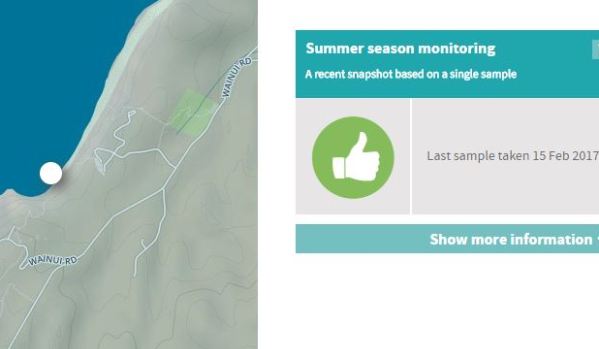Waikato Regional Council News, 23.02.17
New maps add to waters information but show improvements still essential
New Government maps indicating where bacteria and potentially toxic algae are at levels safer for swimming will help Raglanites and Waikato people make choices but further improvements in water quality are still needed, says Waikato Regional Council.
The info for the Raglan area is here Raglan’s Ngarunui Beach is shown as Green – safe to swim 90 to 95% of the time. This is based on four samples taken in January and February 2017.
The Ministry for the Environment maps follow international reporting standards and are designed to help guide people on where they can swim safely without getting sick.
Currently the regional council’s website indicates about a third (34 per cent) of Waikato waterways are swimmable based on national e. coli bacteria and regional clarity criteria at measured sites.
But the ministry maps, which model water quality everywhere in the region, will now indicate where swimming is also OK either 12 months of the year (blue), most of the time (green), some of the time (yellow) or OK now and then (orange). This is purely from an e.coli and cyanobacteria perspective, not clarity. (If clarity is poor a waterway can’t be assumed to be safe for swimming even if other factors are OK.) The lowest category is red.
Percentage of time waters in each category that can be expected to comply with national swimmability standards
- Blue 95 per cent
- Green 90-95 per cent
- Yellow 80-90 per cent
- Orange 70-80 per cent
- Red Less than 70 per cent
Some 48 per cent of Waikato waterways will now fit into one of the ministry’s top three categories where swimming is or may be safe for swimming (blue, green and yellow).
“The public will be able to access the ministry’s information on the Land and Water Aoteroa website, and this will be a useful complement to our website’s information when it comes to people making judgments about which places are safe to swim in,” said council chief executive Vaughan Payne.
“The Land and Water Aotearoa website will have more detailed information on when, or under what conditions, a river may be safe to swim in.”
Mr Payne said ongoing problems with the swimmability of some Waikato waterways highlighted the need to keep making improvements to water quality.
“We’ve seen some really positive major point source discharge clear ups last century in our region, and there have been some more recent improvements in sewage treatment at Te Kuiti, Tirau and Waihi that have had a localised effect on e. coli loads.
“But it’s also important to address e. coli discharges from diffuse sources, such as farm paddocks. There’s no sign yet that other actions in more recent years, such as riparian planting, have reduced e.coli loads from these diffuse sources, despite some very good efforts from farmers.
“We collectively need to keep the momentum up on water quality if we want to make substantial improvements.”
Mr Payne said that each year urban ratepayers are spending something like $60 million on improved quality of discharges to water. Clean up funding of $220 million over 30 years was being made available through the Waikato River Authority. Also, there was a substantial investment being made by landowners, communities and the regional council to improve catchment management to stop erosion and improve water quality.
“Also, the Healthy Rivers Wai Ora plan change and other plan changes to come will help us further.”
“The approach the Government’s taking will form part of our water quality discussion going forward.”
He noted that the Government’s current National Policy Statement for Freshwater Management (NPS-FM) standards for swimmability are still the ones the council must have regard to in achieving the Crown-iwi Vision and Strategy for the Waikato and Waipa rivers under Healthy Rivers Wai Ora.
“Any changes to the NPS-FM can be taken into consideration as we work through the plan change process but for now we are proceeding under the current rule framework.”
